- Home
- About
- Map
- Trips
- Bringing Boat West
- Migration West
- Solo Motorcycle Ride
- Final Family XC Trip
- Colorado Rockies
- Graduates' XC Trip
- Yosemite & Nevada
- Colorado & Utah
- Best of Utah
- Southern Loop
- Pacific Northwest
- Northern Loop
- Los Angeles to NYC
- East Coast Trips
- 1 Week in Quebec
- Southeast Coast
- NH Backpacking
- Martha's Vineyard
- Canadian Maritimes
- Ocracoke Island
- Edisto Island
- First Landing '02
- Hunting Island '02
- Stowe in Winter
- Hunting Island '01
- Lake Placid
- Chesapeake
- Provincetown
- Hunting Island '00
- Acadia in Winter
- Boston Suburbs
- Niagara Falls
- First Landing '99
- Cape Hatteras
- West Coast Trips
- Utah Off-Roading
- Maui
- Mojave 4WD Course
- Colorado River Rafting
- Bishop & Death Valley
- Kauai
- Yosemite Fall
- Utah Off-Road
- Lost Coast
- Yosemite Valley
- Arizona and New Mexico
- Pescadero & Capitola
- Bishop & Death Valley
- San Diego, Anza Borrego, Joshua Tree
- Carmel
- Death Valley in Fall
- Yosemite in the Fall
- Pacific Northwest
- Utah Off-Roading
- Southern CA Deserts
- Yosemite & Covid
- Lake Powell Covid
- Eastern Sierra & Covid
- Bishop & Death Valley
- Central & SE Oregon
- Mojave Road
- Eastern Sierra
- Trinity Alps
- Tuolumne Meadows
- Lake Powell Boating
- Eastern Sierra
- Yosemite Winter
- Hawaii
- 4WD Eastern Sierra
- 4WD Death Valley +
- Southern CA Deserts
- Christmas in Tahoe
- Yosemite & Pinnacles
- Totality
- Yosemite & Sierra
- Yosemite Christmas
- Yosemite, San Diego
- Yosemite & North CA
- Seattle to Sierra
- Southwest Deserts
- Yosemite & Sierra
- Pacific Northwest
- Yosemite & South CA
- Pacific Northwest
- Northern California
- Southern Alaska
- Vancouver Island
- International Trips
- Index
- Tips
- Books
- Photos/Videos
- Search
- Contact
Jökulsárlón Glacier Lagoon and Diamond Beach
Saturday, June 3, 2023 - 2:30pm by Lolo10 miles and 0.25 hours from our last stop
Travelogue
 Jökulsárlón glacier lagoonThere is so much to see along the southern portion of the Ring Road that we didn’t have to drive too far before our next stop - The Jökulsárlón glacier lagoon, where 1,000-year-old, large blue, white, turquoise and black-streaked icebergs shift and bop about the lagoon, before breaking up and heading out to the sea through a narrow channel.
Jökulsárlón glacier lagoonThere is so much to see along the southern portion of the Ring Road that we didn’t have to drive too far before our next stop - The Jökulsárlón glacier lagoon, where 1,000-year-old, large blue, white, turquoise and black-streaked icebergs shift and bop about the lagoon, before breaking up and heading out to the sea through a narrow channel.
It is one of Iceland’s most popular destinations, and understandably so.
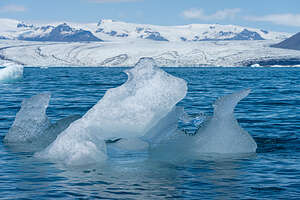 Jökulsárlón Glacier LagoonThis lagoon is less than 100 years old. Located at the head of the Breiðamerkurjökull glacier, the lagoon was formed as the glacier warmed and began receding from the edge of the Atlantic Ocean.
Jökulsárlón Glacier LagoonThis lagoon is less than 100 years old. Located at the head of the Breiðamerkurjökull glacier, the lagoon was formed as the glacier warmed and began receding from the edge of the Atlantic Ocean.
As temperatures continue to rise, the lagoon continues to grow as the glacier recedes even further. Today the lagoon is four times larger than it was in the 1970s, making it the deepest lake in Iceland.
 Jökulsárlón Glacier LagoonAs the glacier calves, it deposits icebergs into the lagoon. Eventually, these icebergs break up and when the chunks are small enough, they start floating across the lagoon towards the channel that connects it to the sea.
Jökulsárlón Glacier LagoonAs the glacier calves, it deposits icebergs into the lagoon. Eventually, these icebergs break up and when the chunks are small enough, they start floating across the lagoon towards the channel that connects it to the sea.
It was like watching the effects of global warming in real time.
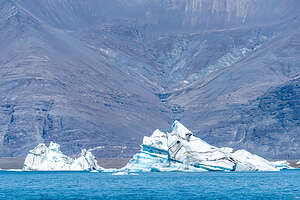 Jökulsárlón Glacier LagoonThere are two ways to spend your time at Jökulsárlón. You can take an amphibian or Zodiac boat ride to get up close and personal to the icebergs on the lagoon, or you can hike around the lagoon’s perimeter.
Jökulsárlón Glacier LagoonThere are two ways to spend your time at Jökulsárlón. You can take an amphibian or Zodiac boat ride to get up close and personal to the icebergs on the lagoon, or you can hike around the lagoon’s perimeter.
We chose to avoid the crowds and walk the trail along the shoreline.
As we strolled along the shore, I began wondering why some of the icebergs were a milky white and some a bright blue. The blue ones were absolutely beautiful.
 Harvesting Ice for Cocktail HourAs I often do, I turned to Google for the answer.
Harvesting Ice for Cocktail HourAs I often do, I turned to Google for the answer.
Blue icebergs are much older than white icebergs, originating from portions of a glacier that are very compressed and have fewer bubbles. The fewer the bubbles the less chance there is of light being scattered, resulting in red wavelengths being absorbed, with only blue light being scattered and escaping the iceberg. Hence, the blue color.
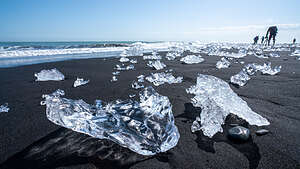 Diamond BeachSome of them were a little blue and a little white, like a peppermint candy.
Diamond BeachSome of them were a little blue and a little white, like a peppermint candy.
As we continued our stroll, Paul and I spotted a piece of ice floating right near the shoreline. We had been lamenting the lack of ice cubes for our cocktails, so we sort of jokingly said that we should capture it. This little chunk of ice was just asking for it.
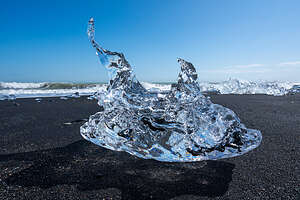 Diamond BeachSo, I ran to the van to get a plastic bag to hold it, while Paul continued to coax it in and lay it on the sand. I’m sure It was quite an entertaining sight to see us giddily wrestle it into the bag. We were quite proud of ourselves.
Diamond BeachSo, I ran to the van to get a plastic bag to hold it, while Paul continued to coax it in and lay it on the sand. I’m sure It was quite an entertaining sight to see us giddily wrestle it into the bag. We were quite proud of ourselves.
After our walk along the lagoon, we drove across the road to the parking lot for Diamond Beach, on the ocean side of the channel.
When the waves and the tides are just right, the icebergs that float through the channel from the lagoon get broken up and washed ashore, littering the beach with glittering chunks of ice.
 Diamond BeachHow much is on the beach at any point in time is very dependent on the tides and the power of the waves. When we first got there, there were only a few little pieces on the beach, so we decided to wait them out by taking a nap in the van. When we re-emerged about a half out later, the beach was strewn with glittering chunks of ice in all shapes and sizes.
Diamond BeachHow much is on the beach at any point in time is very dependent on the tides and the power of the waves. When we first got there, there were only a few little pieces on the beach, so we decided to wait them out by taking a nap in the van. When we re-emerged about a half out later, the beach was strewn with glittering chunks of ice in all shapes and sizes.
When we first arrived, there were only a few scattered pieces strewn across the sand. It was pretty, but not overly impressive.
 A Teddy Bear?Fortunately, we did not leave, but stayed to make lunch and take a quick nap in the vans.
A Teddy Bear?Fortunately, we did not leave, but stayed to make lunch and take a quick nap in the vans.
When we re-emerged, we were astounded. The beach was now covered with dozens and dozens of glittering ice chunks, in all shapes and sizes.
Some of them were milky white, but the most beautiful ones were perfectly clear, reminding me of my mother-in-law’s Swarovski crystal collection.
 Dog or Fish?Once again, I wondered why and once again Google came through for me. Ice appears white when it contains trapped air bubbles and minerals, while clear ice has had the bubbles compressed out of it and is pure of minerals.
Dog or Fish?Once again, I wondered why and once again Google came through for me. Ice appears white when it contains trapped air bubbles and minerals, while clear ice has had the bubbles compressed out of it and is pure of minerals.
Wandering amongst them was like playing the cloud shape game I used to play as a kid, except with 1,000 year old pieces of icebergs rather than clouds.
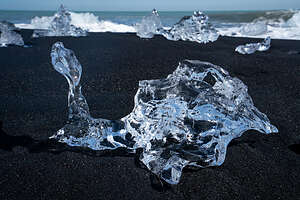 Turtle?One looked like a long-necked turtle, like the kind I saw in the Galapagos. Another one looked like a teddy bear dropped in the sand. One looked like a dog from one side and a fish from the other, so we called it a dogfish.
Turtle?One looked like a long-necked turtle, like the kind I saw in the Galapagos. Another one looked like a teddy bear dropped in the sand. One looked like a dog from one side and a fish from the other, so we called it a dogfish.
I found Herb stalking an ice lizard with his camera.
It was incredible. My only advice is that if you have the time, have patience, and wait for the ice show to begin.
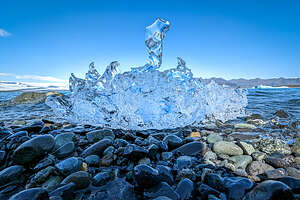 Diamond BeachDiamond Beach was pretty much the last of the highly-visited tourist spots we would see in awhile, aw we were getting out of reach of the Reykjavik tour buses. In another hour or so we would arrive at our final destination for the day - the beautiful Vestrahorn mountain in the southeast corner of Iceland.
Diamond BeachDiamond Beach was pretty much the last of the highly-visited tourist spots we would see in awhile, aw we were getting out of reach of the Reykjavik tour buses. In another hour or so we would arrive at our final destination for the day - the beautiful Vestrahorn mountain in the southeast corner of Iceland.
After that, we would start heading north along the much less traveled eastern coast - zigging in and out amongst the fjords. For the next 10 days, we would pretty much leave the crowds behind and experience a bit more of what Iceland was like before becoming a major tourist attraction. .
Múlagljúfur Canyon
Saturday, June 3, 2023 - 10:15am by Lolo17 miles and 0.5 hours from our last stop
Travelogue
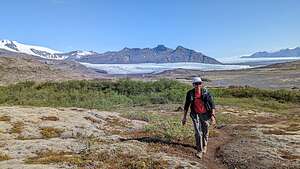 Hiking up Múlagljúfur with Vatnajökull behindDuring my pre-trip research, I came across a supposedly “hidden gem” along the southern portion of the Ring Road called the Múlagljúfur Canyon. Obviously Justin Bieber had not included it in his music video, or it definitely would not still be hidden.
Hiking up Múlagljúfur with Vatnajökull behindDuring my pre-trip research, I came across a supposedly “hidden gem” along the southern portion of the Ring Road called the Múlagljúfur Canyon. Obviously Justin Bieber had not included it in his music video, or it definitely would not still be hidden.
Múl means mule and gljúfur means canyon. Hence, "Múlagljúfur” means Mules Canyon, so I added two more Icelandic words to my vocabulary today. I am practically fluent and it's only day 3 on the Ring Road.
 Hangandifoss viewpointAccording to the directions, unlike every other place of interest along the Ring Road, the turnoff to this canyon was not signed out. Hmm…maybe it could still be a hidden gem. Before leaving home, we marked the turnoff on Google Maps.
Hangandifoss viewpointAccording to the directions, unlike every other place of interest along the Ring Road, the turnoff to this canyon was not signed out. Hmm…maybe it could still be a hidden gem. Before leaving home, we marked the turnoff on Google Maps.
The drive to the trailhead off the Ring Road was a bumpy gravel road, but turned out to be very doable, even in a camper van.
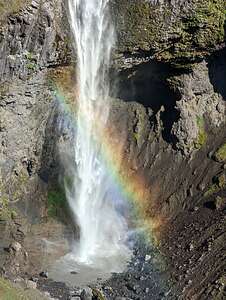 Rainbow over HangandifossThere was only one other car in the parking lot, so this was promising.
Rainbow over HangandifossThere was only one other car in the parking lot, so this was promising.
From the parking lot at the mouth of the canyon, we began hiking up into the canyon, with views of the Vatnajökull glacier behind us all the way.
After about a mile and a half we came to a lovely view of Hangandifoss, one of the tallest waterfalls in Iceland. Its source is the Múlaa River, which is fed by the melting water of the Öræfajökull (glacier), an ice-covered volcano at the southern extremity of the Vatnajökull glacier
Of course, there was a beautiful rainbow in its spray. We’ve come to expect nothing less in this incredibly magic land.
From there we hiked back down from whence we came. We only saw about 5 people the entire time, so it is still pretty much a hidden gem. I only hope it can remain that way.
Hofskirkja
Saturday, June 3, 2023 - 8:45am by Lolo12 miles and 0.3 hours from our last stop
Travelogue
_0.thumbnail.jpg) HofskirkjaToday was our last day on the southern end of the island before we would start heading north along the much less traveled eastern coast - zigging in and out amongst the fjords. For the next 10 days, we would pretty much leave the crowds behind and experience a bit more of what Iceland was like before becoming a major tourist attraction.
HofskirkjaToday was our last day on the southern end of the island before we would start heading north along the much less traveled eastern coast - zigging in and out amongst the fjords. For the next 10 days, we would pretty much leave the crowds behind and experience a bit more of what Iceland was like before becoming a major tourist attraction.
But first, we still had a lot more to see today along the southern coast.
Our first stop of the day was at the lovely Hofskirkja church, the last of the old churches of Iceland to be built in the traditional turf style.
 Hofskirkja cemeterySince the Vikings pretty much deforested most of Iceland over a thousand years ago, timber was in short supply, so they rather resourcefully came up with the idea of using turf instead. Not such a bad idea as it proved to be sturdier than timber in the face of storms and better at keeping the cold out. Plus they are so cute.
Hofskirkja cemeterySince the Vikings pretty much deforested most of Iceland over a thousand years ago, timber was in short supply, so they rather resourcefully came up with the idea of using turf instead. Not such a bad idea as it proved to be sturdier than timber in the face of storms and better at keeping the cold out. Plus they are so cute.
Next to the church was a peaceful little cemetery with grassy mounds adorned by simple white crosses.
As we wandered respectfully through the cemetery, I couldn’t help but notice that everyone’s name ended with the suffix -son or -dottir. A son is given his father’s first name, with the suffix -son added to it and the daughter also has the father’s first name with -dottir added to it.
Today, however, it’s perfectly acceptable to follow the matrilineal line and for children to take their mother’s first name followed by the appropriate suffix.
Laekjavik Coast (East Fjords)
Sunday, June 4, 2023 - 9:00am by Lolo60 miles and 1.5 hours from our last stop
Travelogue
 Roter Stuhl auf FelsenThe following morning before leaving Vestrahorn, we drove back through the access gate to show Herb and Paul the Viking Village that Hilda and I had enjoyed so much the day before.
Roter Stuhl auf FelsenThe following morning before leaving Vestrahorn, we drove back through the access gate to show Herb and Paul the Viking Village that Hilda and I had enjoyed so much the day before.
Then it was back on the Ring Road again. Today, we would be leaving the highly-traveled areas along the southern portion of the Ring Road and heading north along the eastern fjords, along an area referred to as the Laekjavik Coast, which extends for about 60 miles from Vestrahorn to the village of Djupivogur.
 Black sand Beach black and EystrahornAs soon as we pointed our van north, It was like we were entering an entirely new Iceland, or more correctly an old one of how things used to be before it was discovered by tourists from around the world.
Black sand Beach black and EystrahornAs soon as we pointed our van north, It was like we were entering an entirely new Iceland, or more correctly an old one of how things used to be before it was discovered by tourists from around the world.
The Ring Road along the East Fjords follows an incredibly beautiful rocky coastline, with steep cliffs and mountains dropping dramatically down to the ocean, sea stacks off the coast, and the occasional quaint fishing village along the way.
 Djupivogur's Eggin í GleðivíkWe hadn't gotten too far before we came across a rather random bright red chair set atop a rock alongside the road. It is called Roter Stuhl Auf Felsen (Red Chair on a Rock), and, of course, it had to be sat on. There was a very nice view of Eystrahorn (Vestrahorn’s sister mountain) behind us. I wish I knew the story behind this, but thank you to whoever had the foresight to place it in this lovely location.
Djupivogur's Eggin í GleðivíkWe hadn't gotten too far before we came across a rather random bright red chair set atop a rock alongside the road. It is called Roter Stuhl Auf Felsen (Red Chair on a Rock), and, of course, it had to be sat on. There was a very nice view of Eystrahorn (Vestrahorn’s sister mountain) behind us. I wish I knew the story behind this, but thank you to whoever had the foresight to place it in this lovely location.
A little further along, we turned off into a pullout for the Hvalnes Lighthouse. From the lighthouse area, we climbed up a small hill and looked down upon a beautiful black sand beach with Eystrahorn (Vestrahorn’s sister mountain) in the background.
 I felt a need to hug oneContinuing on, we stopped at the small village of Djupivogur, which has the oldest port in Iceland, dating back to the 16th century.
I felt a need to hug oneContinuing on, we stopped at the small village of Djupivogur, which has the oldest port in Iceland, dating back to the 16th century.
It also had some more contemporary art - 34 over-sized eggs along the jetty. It’s called The Eggs of Merry Bay (Eggin í Gleðivík in Icelandic) and they are a tribute to the 34 native birds of eastern Iceland.
Each stone specimen accurately depicts the shape, patterns, and colors of the individual bird egg it represents. Each egg has a sign giving the bird’s name (both genus and species) in Latin and its common name in Icelandic. Of course, Herb found it necessary to photograph Turdus Iliacus
I couldn’t resist hugging one.
Then it was on to Seyðisfjörður, considered the most beautiful village in Eastern Iceland, for lunch.
Skaftafell - Svartifoss and Skaftafellsjökull
Friday, June 2, 2023 - 4:45pm by Lolo50 miles and 1 hour from our last stop - 1 night stay
Travelogue
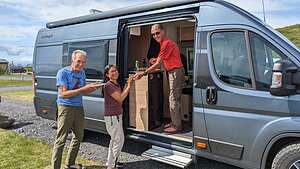 Herb's PylsursAfter leaving Fjaðrárgljúfur Canyon, we drove for about another hour to Skaftafell, where we planned to spend the night.
Herb's PylsursAfter leaving Fjaðrárgljúfur Canyon, we drove for about another hour to Skaftafell, where we planned to spend the night.
Skaftafell was once its own National Park, but in 2008 it became part of the larger Vatnajökull National Park. Vatnajökull has a lot of superlatives associated with it: not only is it one of the largest national parks in Europe, but its ice cap (also called Vatnajökull) is the largest ice cap in Europe. It is so large that if covers 11% of the surface area of Iceland - or at least it did before global warming began melting most of the world’s ice caps.
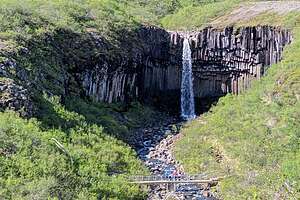 Heart-shaped SvartifossVatnajökull National Park has several entry points, but Skaftafell is the best place to explore the park from the southern side.
Heart-shaped SvartifossVatnajökull National Park has several entry points, but Skaftafell is the best place to explore the park from the southern side.
We didn’t know it yet, but the Skaftafell campground would be the nicest one we would stay in during the entire trip. Most of the campgrounds in Iceland are basically grassy areas that you park on with a range of facilities. All have bathrooms and most have showers, but usually not enough for the amount of people camping there.
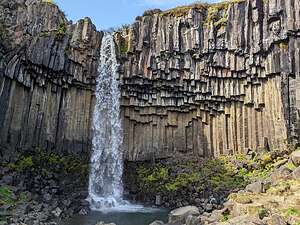 SvartifossThis one was in a lovely setting with a gravel area to park in surrounded by a grassy area to sit out in. It also had great facilities (lots of bathrooms and showers, laundry, etc.). However, even more importantly, it was located near the trailhead for the two hikes we planned to do today: Svartifoss (waterfall) and Skaftafellsjökull (glacier), so we didn’t have to move the campers.
SvartifossThis one was in a lovely setting with a gravel area to park in surrounded by a grassy area to sit out in. It also had great facilities (lots of bathrooms and showers, laundry, etc.). However, even more importantly, it was located near the trailhead for the two hikes we planned to do today: Svartifoss (waterfall) and Skaftafellsjökull (glacier), so we didn’t have to move the campers.
Since this was going to be our base camp for the day’s activities, we got there right around lunchtime. We were not particularly creative with our menu when cooking in the van, mostly because we ate out whenever possible.
 Svartifoss close-upHowever, we did find that Herb’s bratwurst (sort of a German Pylsur) and Hilda’s salads were easy and tasty. So that’s what we did.
Svartifoss close-upHowever, we did find that Herb’s bratwurst (sort of a German Pylsur) and Hilda’s salads were easy and tasty. So that’s what we did.
This was the first day that it was actually warm enough to sit outside in shorts and a t-shirt, definitely not the Iceland we expected. We were very, very lucky with the weather - the forecast had 10 days of sunshine and fairly warm (for Iceland) temperatures in the upper 50s and lower 60s - definitely much better than the cold, rainy weather more typical this time of the year.
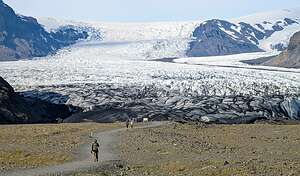 Approaching SkaftafellsjökullAfter lunch and a brief siesta, we set out on a 3-mile hike to Svartifoss, which is Icelandic for “Black Waterfall,” because of its beautiful backdrop of black hexagonal basalt columns.
Approaching SkaftafellsjökullAfter lunch and a brief siesta, we set out on a 3-mile hike to Svartifoss, which is Icelandic for “Black Waterfall,” because of its beautiful backdrop of black hexagonal basalt columns.
The water originates from the Svinafellsjokull glacier, also in Vatnajökull National Park, and plunges 80 feet over a cliff into a heart-shaped amphitheater surrounded by tall black basalt columns. These columns were created by lava rapidly cooling and contracting over centuries, typically splitting into six-sided columns.
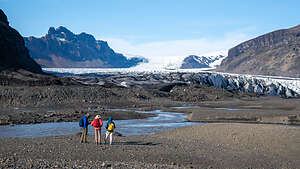 SkaftafellsjökullIf you look really close, you can see that the rock faces are marked by narrow horizontal bands. This is due to slow fracturing events as the columns cascade downwards. Bit by bit, the basalt crystals break off and plunge into the river at the base of the falls.
SkaftafellsjökullIf you look really close, you can see that the rock faces are marked by narrow horizontal bands. This is due to slow fracturing events as the columns cascade downwards. Bit by bit, the basalt crystals break off and plunge into the river at the base of the falls.
Although not necessarily one of the tallest waterfalls we would see, it certainly is one of the most picturesque, and served as the inspiration for architect Guðjón Samúelsson’s design of Reykjavik’s Hallgrímskirkja, the largest church in Iceland.
After Svartifoss we hiked another 3.5-miles to Skaftafellsjökull, a glacier tongue spurting off from Iceland's largest ice cap, Vatnajökull. Just like “foss” means waterfall in Icelandic, “jökull” means glacier. I had now doubled my Icelandic vocabulary
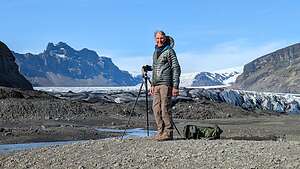 Happy HerbIt was massive, despite the fact that over the last decade, Skaftafellsjökull has been receding dramatically, serving as another example of how climate change is steadily affecting the glaciers in Iceland and how stronger environmental policies are needed asap to preserve the world’s glaciers.
Happy HerbIt was massive, despite the fact that over the last decade, Skaftafellsjökull has been receding dramatically, serving as another example of how climate change is steadily affecting the glaciers in Iceland and how stronger environmental policies are needed asap to preserve the world’s glaciers.
Foolishly we thought we would be able to walk on the glacier, not realizing that there would be so much water between our trail and it, because of the great amount of melting occurring. So, we satisfied ourselves by admiring it from afar.
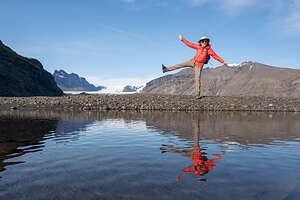 Happy LoloI became curious as to why the edge of the tongue was so black and dirty looking, so when I got home I tried to find out why.
Happy LoloI became curious as to why the edge of the tongue was so black and dirty looking, so when I got home I tried to find out why.
What I discovered is that a substance called Cryoconite, which is a powdery windblown dust made of a combination of small rock particles, soot and bacteria, gets trapped in holes in the glacier’s surface.
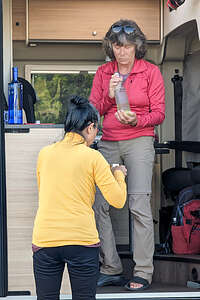 My wine barWhile many of the materials in cryoconite are natural materials, human activities based on coal use have increased the amount of black soot in cryoconite since the substance was first discovered in 1870, causing glaciers to darken in a phenomenon scientists call “biological darkening.” Besides being aesthetically unpleasing, this darker surface absorbs rather than reflects heat from the sun’s rays, making snow and glaciers melt more quickly.
My wine barWhile many of the materials in cryoconite are natural materials, human activities based on coal use have increased the amount of black soot in cryoconite since the substance was first discovered in 1870, causing glaciers to darken in a phenomenon scientists call “biological darkening.” Besides being aesthetically unpleasing, this darker surface absorbs rather than reflects heat from the sun’s rays, making snow and glaciers melt more quickly.
Skaftafellsjökull was still an overwhelmingly impressive sight to see, so we figured we should enjoy it while we still could. I only hope that it will still be around for my grandchildren (who don’t exist yet) to enjoy in their lifetime.
What an incredible variety of experiences in two short hikes!
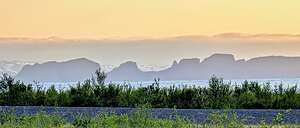 View from our camper at 10 pmWhen we got back to our campsite, it was still a lovely evening, a bit cooler, but still warm enough to sit outside for cocktail hour.
View from our camper at 10 pmWhen we got back to our campsite, it was still a lovely evening, a bit cooler, but still warm enough to sit outside for cocktail hour.
Later on, after everyone had gone to bed, I walked outside our camper and was treated to a splendid display of colors - snow-covered mountains squeezed between blues and the golden light of pre-sunset. It was 10:00 pm, but there was still plenty of light in the land of the Midnight Sun.
Fjaðrárgljúfur Canyon
Friday, June 2, 2023 - 9:30am by Lolo4 miles and 0.25 hours from our last stop
Travelogue
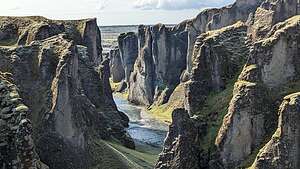 Fjaðrárgljúfur CanyonAs I mentioned, Herb and I had watched hours of YouTube videos about Iceland while planning our itinerary. I hate to admit that one of those was a Justin Bieber music video where he was prancing around on precarious outcrops over a stunning canyon called Fjaðrárgljúfur.
Fjaðrárgljúfur CanyonAs I mentioned, Herb and I had watched hours of YouTube videos about Iceland while planning our itinerary. I hate to admit that one of those was a Justin Bieber music video where he was prancing around on precarious outcrops over a stunning canyon called Fjaðrárgljúfur.
It popularized that canyon so much and became so overrun with visitors that local authorities closed it to the public to protect the vegetation. In fact, when we looked for directions to it on Google Maps, it still said it was temporarily closed.
Since it was only a 2 mile diversion off the Ring Road, we decided to ignore that, as Google is not invincible, and try going there anyway. Luckily, we did, because there were already plenty of people there.
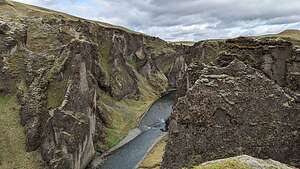 Fjaðrárgljúfur CanyonJustin Bieber has good taste. It is an absolutely stunning narrow river canyon, approximately 100 meters tall and 2 km in length running through layers of soft granular rock, with Gothic-like spires and odd geological formations at the top.
Fjaðrárgljúfur CanyonJustin Bieber has good taste. It is an absolutely stunning narrow river canyon, approximately 100 meters tall and 2 km in length running through layers of soft granular rock, with Gothic-like spires and odd geological formations at the top.
It looks like it belongs in the world of Game of Thrones, and for good reason, as dragons fly through it in the Season 8 Trailer.
No dragons or Justin Bieber’s today though - just people like us out enjoying this amazingly beautiful setting.
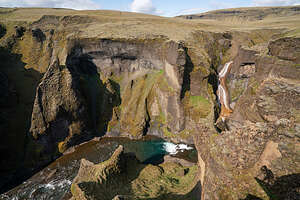 Mögáfoss in Fjaðrárgljúfur CanyonThe only sign that Justin Bieber had been there is that there are now fences along the edge of the canyon preventing us from doing fancy dance moves out on a precarious outcrop
Mögáfoss in Fjaðrárgljúfur CanyonThe only sign that Justin Bieber had been there is that there are now fences along the edge of the canyon preventing us from doing fancy dance moves out on a precarious outcrop
At the head of the canyon we came to the beautiful Mögáfoss (waterfall), where the Möga river meets the Fjaðrá river and cascades down into the canyon.
That was the end of the trail, so we hiked back from whence we came and continued on the Ring Road to Skaftafell National Park, where we planned to spend the night.
Eldhraun Lava Fields
Friday, June 2, 2023 - 8:30am by Lolo10 miles and 0.5 hours from our last stop
Travelogue
 Eldhraun Lava FieldLeaving the town of Vik, we continued east along the southern end of Iceland through an amazing variety of landscapes.
Eldhraun Lava FieldLeaving the town of Vik, we continued east along the southern end of Iceland through an amazing variety of landscapes.
Our first stop of the day was the Eldhraun Lava Fields, right alongside the Ring Road. Covering over 218 square miles, it is the biggest lava field in the world.
.thumbnail.jpg) Eldhraun Lava FieldsThis lava field was created by one of the most violent volcanic eruptions in history, the Lakagígar eruption in the 1700s. This eruption, which lasted from 1783 to 1784, was a cataclysmic event for Iceland, which led to disease, crop failure, and famine. As a result, between 50 and 80% of domestic animals and 20% of the human population perished.
Eldhraun Lava FieldsThis lava field was created by one of the most violent volcanic eruptions in history, the Lakagígar eruption in the 1700s. This eruption, which lasted from 1783 to 1784, was a cataclysmic event for Iceland, which led to disease, crop failure, and famine. As a result, between 50 and 80% of domestic animals and 20% of the human population perished.
The Eldhraun Lava Fields are an example of how plant life begins after a volcanic eruption. At first the lava flow is barren, but then a process of colonization begins, very often, as in this case with mosses. It seemed like a weird juxtaposition, but Iceland does get a lot of rain, so mosses thrive.
.thumbnail.jpg) View from Eldhraun Lava FieldsThe Eldhraun lava field is covered with a special type of moss called woolly fringe moss, a very fragile moss which takes about a hundred years to grow. That is why environmental scientists were so angered by Justin Bieber dancing and trampling the moss here in the filming of his famous music video “I’ll Show You”.
View from Eldhraun Lava FieldsThe Eldhraun lava field is covered with a special type of moss called woolly fringe moss, a very fragile moss which takes about a hundred years to grow. That is why environmental scientists were so angered by Justin Bieber dancing and trampling the moss here in the filming of his famous music video “I’ll Show You”.
The landscape is so otherworldly that NASA astronauts used this lava field to train for the Apollo 11 mission, because they believed that Eldhraun’s landscape and geological conditions would match those of the moon.
The view of the surrounding landscape from the lava fields was lovely and pristine. Hard to believe that this was the site of such a cataclysmic event.
Vik - Dyrhólaey and Reynisfjara Black Sand Beach
Thursday, June 1, 2023 - 6:45pm by Lolo21 miles and 0.5 hours from our last stop - 1 night stay
Travelogue
.thumbnail.jpg) Dyrhólaey promontoryBefore settling down for the night in a campground in the small village of Vik (population 750), we drove out to the end of the Dyrhólaey peninsula, near the southernmost point of Iceland.
Dyrhólaey promontoryBefore settling down for the night in a campground in the small village of Vik (population 750), we drove out to the end of the Dyrhólaey peninsula, near the southernmost point of Iceland.
Until 1918 the Dyrhólaey promontory actually was the southernmost point of mainland Iceland, but then the Katla volcano erupted creating the landmass of Kötlutangi which is now the southernmost point. As we would continue to learn, volcanic activity very much shaped the landscape of Iceland and continues to do so to this day.
.thumbnail.jpg) ArnardrangurThe Dyrhólaey Reserve is split into two sections: Háey (“the high island”) and Lágey (“the low island”) that each offer different views and experiences.
ArnardrangurThe Dyrhólaey Reserve is split into two sections: Háey (“the high island”) and Lágey (“the low island”) that each offer different views and experiences.
The higher area is where the lighthouse is and the best views of the iconic rock arch. Unfortunately, this area is only reached by a rough 4WD or a hike from the lower area.
So instead, we stayed straight at the fork and parked in the lower area parking lot. From there we followed a gravel pathway in the direction of the water for only about 100 feet before reaching the first viewing area, where we looked out over a large volcanic rock, named Arnardrangur, rising from the sand.
.thumbnail.jpg) View from DyrhólaeyDuring low tide you can walk right up to Arnardrangur, but waves were beginning to lap its base and we weren’t sure if the tide was going out or in, so not a good idea for today.
View from DyrhólaeyDuring low tide you can walk right up to Arnardrangur, but waves were beginning to lap its base and we weren’t sure if the tide was going out or in, so not a good idea for today.
From there we continued up a small hill, from which there was a great view of Reynisfjara Black Sand Beach and its iconic basalt sea stacks known as Reynisrangar. These sea stacks were featured in Season 7 of Game of Thrones. More about them a little later.
There was also a beautiful arch made of basalt.
.thumbnail.jpg) Hálsanefshellir Cave on Reynisfjara BeachIt was too windy to walk to the lighthouse, so we drove over to Reynisfjara Black Sand Beach to see the Reynisrangar sea stacks up close. The waves on this beach can be so powerful that they even post warning levels for the day as to how dangerous the waves are. Tourists have actually been swept out to sea. Today was yellow. However, a bigger problem was the wind which was blowing so hard that we were being pelted with the black sand.
Hálsanefshellir Cave on Reynisfjara BeachIt was too windy to walk to the lighthouse, so we drove over to Reynisfjara Black Sand Beach to see the Reynisrangar sea stacks up close. The waves on this beach can be so powerful that they even post warning levels for the day as to how dangerous the waves are. Tourists have actually been swept out to sea. Today was yellow. However, a bigger problem was the wind which was blowing so hard that we were being pelted with the black sand.
I knew about the sea stacks on Reynisfjara Beach, but we were delighted to also find a beautiful basalt cave, known as Hálsanefshellir. This would be the first of many times that we would see basalt columns along our journey. After all, Iceland was created by volcanic activity.
.thumbnail.jpg) Hálsanefshellir CaveOutside the cave, lots of people (half my age) were climbing up and posing on the basalt columns. For some reason, I felt a need to do the same.
Hálsanefshellir CaveOutside the cave, lots of people (half my age) were climbing up and posing on the basalt columns. For some reason, I felt a need to do the same.
A little further down the beach we came close to the two iconic basalt sea stacks known as Reynisrangar.
Since this is Iceland, of course there is a legend explaining their creation. In fact, there are several versions, but all of them involve trolls.
Trolls are very much a part of Icelandic mythology, and many Icelanders still believe in, or at least don’t totally deny, their existence.
.thumbnail.jpg) Climbing the basalt columns of ReynisfjaraOne legend says that the stacks originated when two trolls dragged a three-masted ship to land unsuccessfully and when daylight broke they became needles of rock. Trolls do not do well with sunlight.
Climbing the basalt columns of ReynisfjaraOne legend says that the stacks originated when two trolls dragged a three-masted ship to land unsuccessfully and when daylight broke they became needles of rock. Trolls do not do well with sunlight.
Another more contemporary legend claims that these large basalt columns were once trolls that kidnapped a woman and killed her. The bereaved husband followed the trolls to Reynisfjara where he froze them, turning them into stone.
The wind was getting so bad that we decided to head back to the town of Vik and find the campsite.
.thumbnail.jpg) Reynisrangar iconic basalt sea stacksFrom there we walked to Restaurant Suður-Vík, which had a cozy, pub-like setting with good food. It seemed like there were a lot of locals there, which is always a good sign.
Reynisrangar iconic basalt sea stacksFrom there we walked to Restaurant Suður-Vík, which had a cozy, pub-like setting with good food. It seemed like there were a lot of locals there, which is always a good sign.
After dinner, we decided to walk to the Vík i Myrdal Lutheran Church, which we’ve seen in so many photos, most of them from atop a hill or with a field of lupine in the foreground - neither of which we could find.
We did find the church, however, and it is very beautiful, in a simple way, as most of the older churches in Iceland are.
It sits atop a prominent hill, visible from everywhere in the village, or at least when it’s not as foggy as it was tonight.
.thumbnail.jpg) Vík i Myrdal Lutheran ChurchBesides being a beautiful location for a church, it was placed here for a more ominous reason. The Mýrdalsjökull glacier, which lies on top of the Katla volcano, is directly north of Vik. It last erupted in 1918 and is thought to be overdue for another eruption. If it does, it could melt enough ice to trigger an enormous flash flood, wiping out the entire town. The church is believed to be the only building that could survive such a flood. The people of Vik even hold periodic drills and are trained to rush to the church at the first sign of an eruption.
Vík i Myrdal Lutheran ChurchBesides being a beautiful location for a church, it was placed here for a more ominous reason. The Mýrdalsjökull glacier, which lies on top of the Katla volcano, is directly north of Vik. It last erupted in 1918 and is thought to be overdue for another eruption. If it does, it could melt enough ice to trigger an enormous flash flood, wiping out the entire town. The church is believed to be the only building that could survive such a flood. The people of Vik even hold periodic drills and are trained to rush to the church at the first sign of an eruption.
We tried to take an interesting shortcut back to the campground, which required us to slip and slide a bit down a steep ravine. However, we made it back to our home for the night, tired and happy.
Skogafoss
Thursday, June 1, 2023 - 11:00am by Lolo20 miles and 0.5 hours from our last stop
Travelogue
.thumbnail.jpg) Skogafoss double rainbowContinuing along the Ring Road along the Southern part of Iceland, in less than a half hour we came to another beautiful waterfall called Skogafoss, named after the river that feeds it. By now the crowds from Reykjavik had caught up to us.
Skogafoss double rainbowContinuing along the Ring Road along the Southern part of Iceland, in less than a half hour we came to another beautiful waterfall called Skogafoss, named after the river that feeds it. By now the crowds from Reykjavik had caught up to us.
What we would gradually learn during our travels was that each of the waterfalls we visited was unique and distinct from the others - definitely not a “seen one, seen them all” situation.
Skogafoss is one of the biggest waterfalls in Iceland, with a vertical drop of 60 meters and a width of 25 meters and although we couldn’t walk behind it, like we did at Seljalandsfoss, we could go right up to it and get equally drenched.
.thumbnail.jpg) Lolo and her rainbowThe waterfall kicks off so much spray that when it’s sunny there is almost always a beautiful rainbow, sometimes even a double one. Today, conditions were just right for a double, and I was lucky enough to have one encircle me.
Lolo and her rainbowThe waterfall kicks off so much spray that when it’s sunny there is almost always a beautiful rainbow, sometimes even a double one. Today, conditions were just right for a double, and I was lucky enough to have one encircle me.
As with most things in Iceland, there is a legend about this waterfall. The story goes that around the year 900, a Viking Settler named Þrasi Þórólfsson hid a chest filled with gold and treasures behind Skogafoss and said that the first man who went behind the falls would find great treasures.
.thumbnail.jpg) The path to the topIt was said that in olden times one could see one side of the chest protruding from the waterfall. Many tried to retrieve it but the falls were just too powerful.
The path to the topIt was said that in olden times one could see one side of the chest protruding from the waterfall. Many tried to retrieve it but the falls were just too powerful.
One man almost succeeded by tying a rope to the handle of the chest and pulling. He was only able to obtain the ring of the chest, which is said to now hang from the church door in the small village of Skógar.
As far I know, no one has successfully gone behind the falls, so it must still be there.
.thumbnail.jpg) Cascades above SkogafossNo treasure hunting for us today. Instead we hiked up the 527 steps of the steep path to the right of the waterfalls where we looked down on Skogafoss and its rainbow.
Cascades above SkogafossNo treasure hunting for us today. Instead we hiked up the 527 steps of the steep path to the right of the waterfalls where we looked down on Skogafoss and its rainbow.
The top of the falls is the turning around point for most of the crowd, but we continued on for about a mile along a path that traced the Skoga River, passing several other smaller falls and cascades along the way.
The trail continued on for many more miles, passing as many as 30 small waterfalls, but we had lots of things to see and do today, so we turned around and headed back from whence we came.
Seljalandsfoss
Thursday, June 1, 2023 - 9:00am by Lolo80 miles and 1.75 hours from our last stop
Travelogue
.thumbnail.jpg) Seljandafoss before the crowdsReykjavik had been great, but we were anxious to set out on our journey along the Ring Road. We decided to go in a counter-clockwise direction, which meant we would be doing the highly touristed sections along the Southern Coast first before getting to the quieter and more remote Eastern, Northern, and Western sections of the island.
Seljandafoss before the crowdsReykjavik had been great, but we were anxious to set out on our journey along the Ring Road. We decided to go in a counter-clockwise direction, which meant we would be doing the highly touristed sections along the Southern Coast first before getting to the quieter and more remote Eastern, Northern, and Western sections of the island.
.thumbnail.jpg) SeljandafossSo today, we would see two beautiful waterfalls and a lovely black sand beach with basalt columns and sea stacks off the coast before settling in for the night in a campground in Vik, the southernmost village in Iceland
SeljandafossSo today, we would see two beautiful waterfalls and a lovely black sand beach with basalt columns and sea stacks off the coast before settling in for the night in a campground in Vik, the southernmost village in Iceland
Our first stop along the Ring Road was Seljalandsfoss, just 1 hour and 40 minutes from Reykjavik, so you have to get here early to beat the tour buses. As you can see from me being the only one on the trail, our 9:00 arrival was good enough to get the falls to ourselves, if only for a brief period.
The most distinguishing feature of Seljalandsfoss is a pathway that stretches from the front of the waterfall around to the back, where there is a cave-like rocky overhang where you can see through the falls.
 Behind the fallsIt’s very wet back there, but fortunately we had on rain pants and rain jackets. I, however, had no protection for my phone, so I had to let Herb be in charge of behind the waterfall photos.
Behind the fallsIt’s very wet back there, but fortunately we had on rain pants and rain jackets. I, however, had no protection for my phone, so I had to let Herb be in charge of behind the waterfall photos.
The source of this lovely waterfall is the river Seljalandsá, which has its origins underneath the glacier Eyjafjallajökull. This is the glacier that erupted in 2010, sending a plume of volcanic ash over 9 km into the sky, disrupting air travel across all of Western Europe for almost a month. Volcanic activity is a real thing in Iceland, sort of like hurricanes are in Florida, and wildfires in California, a natural disaster that people have learned to live with.
Another interesting fact is that the tall cliff that the waterfalls flows over once marked the country's coastline. The sea is now located across a stretch of lowlands visible from the waterfall.
So, we learned our first Icelandic word today: "foss," which means waterfall, and there are over 10,000 fosses in Iceland. With a population of only 372,000 people that means there is a waterfall for every 37 people. Imagine that in the U.S.
Oh, and one last fun fact. This waterfall, along with a multitude of South Iceland’s most famous natural attractions, can be seen in Justin Bieber’s music video for his song ‘I’ll Show You’.
Next stop - Skogafoss.
